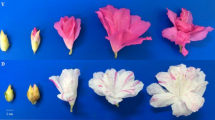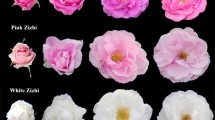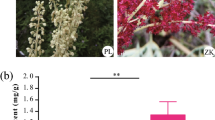Abstract
Rhododendron genus is famous with important ecology impacts, ornamental values, and high medicine values. To obtain a comprehensive overview of anthocyanin regulatory networks, RNA-seq and de novo assembly of five Rhododendron species flower tissues were performed, generating 159,408 unigenes with an average length of 490 bp and an N50 of 552 bp. In particular, 106,766 unigenes could be annotated. Flavonoid biosynthesis was the most abundant KEGG pathway. Genes controlling flower color varied in different species: transcripts involving in carotenoid biosynthesis and isoflavonoid biosynthesis highly expressed in Rhododendron molle G. Don possessing yellow color flower; genes involved in flavone and flavonol biosynthesis showed higher abundance in Rhododendron fortune Lindl. with light pink flowers; transcripts of unigenes participated in flavonoid biosynthesis exhibited higher levels in Rhododendron mariesii Hemsl. with pink color; unigenes involved in anthocyanin biosynthesis showed higher mRNA levels in Rhododendron simsii Planch. with red color; genes involved in carotenoid biosynthesis and flavonoid biosynthesis showed higher expression levels in Rhododendron pulchrum Sweet with purplish red flowers. The five species were clustered into two main groups: group 1 (R. fortune and R. mariesii) and group 2 (R. simsii, R. molle and R. pulchrum) based on expression levels of differentially expressed genes (DEGs). In particular, R. molle showed a closer relationship with R. simsii. This study will provide rich genetic information for further mechanism analysis of flower color variation and genetic improvement of flower color in Rhododendron species.






Similar content being viewed by others
Availability of data and materials
All sequence data generated or supported the findings of this study have been deposited in NCBI (Accession: SRS1967671).
References
Alfenito MR, Souer E, Goodman CD, Buell R, Mol J, Koes R, Walbot V (1998) Functional complementation of anthocyanin sequestration in the vacuole by widely divergent glutathione s-transferases. Plant Cell 10:1135–1149
Ayabe SI, Akashi T (2006) Cytochrome P450s in flavonoid metabolism. Phytochem Rev 5:271–282
Cai Y, Sun M, Corke H (2003) Antioxidant activity of betalains from plants of the Amaranthaceae. J Agr Food Chem 51:2288–2294
Cheon KS, Nakatsuka A, Kobayashi N (2011) Isolation and expression pattern of genes related to flower initiation in the evergreen azalea, Rhododendron × pulchrum ‘Oomurasaki.’ Sci Hortic 130:906–912
Cheon KS, Nakatsuka A, Tasaki K (2013) Expression pattern of several flowering-related genes during flower bud formation in Rhododendron×pulchrum “oomurasaki.” J JPN Soc Hortic Sci 82:263–269
Choudhary S, Thakur S, Najar RA, Majeed A, Singh A, Bhardwaj P (2018) Transcriptome characterization and screening of molecular markers in ecologically important Himalayan species (Rhododendron arboreum). Genome 61:417–428
Christiaens A, Pauwels E, Gobin B, Van Labeke MC (2015) Flower differentiation of azalea depends on genotype and not on the use of plant growth regulators. Plant Growth Regul 75:245–252
Daiki M, Akira N, Takuya B, Ikuo M, Nobuo K (2014) Pigment composition patterns and expression of anthocyanin biosynthesis genes in Rhododendron kiusianum, R. kaempferi, and their natural hybrids on Kirishima Mountain mass Japan. J Jpn Soc Hortic Sci 83:156–162
De KE, Desmet L, Van BE, De RJ (2013) How to perform RT-qPCR accurately in plant species? A case study on flower colour gene expression in an azalea (Rhododendron simsii hybrids) mapping population. BMC Mol Biol 14:1–15
Dewey CN, Li B (2011) RSEM: accurate transcript quantification from RNA-Seq data with or without a reference genome. BMC Bioinform 12:323–323
Dunemann F, Kahnau R, Stange I (1999) Analysis of complex leaf and flower characters in Rhododendron using a molecular linkage map. Theor Appl Genet 98:1146–1155
Fang L, Tong J, Dong YF, Xu DY, Mao J, Zhou Y (2017) De novo RNA sequencing transcriptome of Rhododendron obtusum identified the early heat response genes involved in the transcriptional regulation of photosynthesis. PloS One 12:e0186376
Gao L, Yang H, Liu H, Hu Y (2016) Extensive transcriptome changes underlying the flower color intensity variation in Paeonia ostii. Front Plant Sci 6:1205
Gautam V, Kohli SK, Kapoor D, Bakshi P, Ahmad P (2020) Stress protective effect of Rhododendron arboreum leaves (MEL) on chromium-treated vigna radiata plants. J Plant Growth Regul. https://doi.org/10.1007/s10681-012-0809-7
Grabherr MG, Haas BJ, Yassour M, Levin JZ, Thompson DA, Amit I, Adiconis X, Fab L, Raychowdhury R, Zeng QD, Chen ZH, Mauceli E, Hacohen N, Gnirke A, Rhind N, di Palma F, Birren BW, Nusbaum C, Lindblad-Toh K, Friedman N, Regev A (2011) Full-length transcriptome assembly from RNA-Seq data without a reference genome. Nat Biotech 29:644–652
Grotewold E (2006) The genetics and biochemistry of floral pigments. Annu Rev Plant Biol 57:761–780
Guterman I, Shalit M, Menda N, Piestun D, Dafny-Yelin M, Shalev G, Bar E, Davydov O, Ovadis M, Emanuel M, Wang JH, Adam Z, Pichersky E, Lewinsohn E, Zamir D, Vainstein A, Weiss D (2002) Rose Scent: genomics approach to discovering novel floral fragrance–related genes. Plant Cell 14:2325–2338
Hill CB, Cassin A, Keeble-Gagnère G, Doblin MS, Bacic A, Roessner U (2016) De novo transcriptome assembly and analysis of differentially expressed genes of two barley genotypes reveal root-zone-specific responses to salt exposure. Sci Rep 6:31558
Irish VF (2010) The flowering of Arabidopsis flower development. Plant J 61:1014
Kanehisa M, Goto S (2000) KEGG: kyoto encyclopedia of genes and genomes. Nucleic Acids Res 28:27–30
Katia P, Chiara T (2011) Recent advances on the regulation of anthocyanin synthesis in reproductive organs. Plant Sci 181:219–229
Keyser ED, Lootens P, Bockstaele EV, Riek JD (2013) Image analysis for QTL mapping of flower colour and leaf characteristics in pot azalea. Euphytica 189:445–460
Liang M, Yang X, Li H, Su S, Yi H, Chai L, Deng X (2015) De novo transcriptome assembly of pummelo and molecular marker development. PLoS One 10:e0120615
Marrs KA, Alfenito MR, Lloyd AM, Walbot V (1995) A glutathione S-transferase involved in vacuolar transfer encoded by the maize gene Bronze-2. Nature 375:397–400
Mizuta D, Ban T, Miyajima I, Nakatsuka A, Kobayashi N (2009) Comparison of flower color with anthocyanin composition patterns in evergreen azalea. Sci Hortic 122:594–602
Mouradov A, Cermer F, Coupland G (2002) Control of flowering time: interacting pathways as a basis for diversity. Plant Cell 14:S111–S130
Nakatsuka A, Mizuta D, Kii Y, Miyajima I, Kobayashi N (2008) Isolation and expression analysis of flavonoid biosynthesis genes in evergreen azalea. Sci Horti 118:314–320
Nishihara M, Nakatsuka T (2011) Genetic engineering of flavonoid pigments to modify flower color in floricultural plants. Biotechnol Let 33:433–441
Ozsolak F, Milos PM (2011) Single-molecule direct RNA sequencing without cDNA synthesis. Wires RNA 2:565–570
Popescu R, Kopp B (2013) The genus Rhododendron: an ethnopharmacological and toxicological review. J Ethnopharmacol 147:42–62
Rock CD, Zeevaart JA (1991) The aba mutant of Arabidopsis thaliana is impaired in epoxy-carotenoid biosynthesis. Proc Natl Acad Sci USA 88:7496–7499
Scheiber SM, Jarret RL, Robacker CD, Newman M (2000) Genetic relationships within Rhododendron L. section Pentanthera G. Don based on sequences of the internal transcribed spacer (ITS) region. Sci Hortic 85:123–135
Smith-Unna R, Boursnell C, Patro R, Hibberd JM, Kelly S (2016) TransRate: reference-free quality assessment of de novo transcriptome assemblies. Genome Res 26:1134–1144
Sun H, Wang J, Que J, Peng Y, Yu Y, Wang L, Ye H, Huang K, Xue Y, Zhou Y, Ji K (2019) RNA sequencing revealing the role of amp-activated protein kinase signaling in mice myocardial ischemia reperfusion injury. Gene 703:91–101
Wang XQ, Huang Y, Long CL (2010) Cross-amplification and characterization of microsatellite loci for the genus Rhododendron. HortScience 45:1394–1397
Wang S, Li Z, Jin W, Famg Y, Yang Q, Xiang J (2018) Transcriptome analysis and identification of genes associated with flower development in Rhododendron pulchrum Sweet (Ericaceae). Gene 679:108–118
Wang S, Huang S, Yang J, Li Z, Zhang M, Fang Y, Yang Q, Jin W (2021) Metabolite profiling of violet, white and pink flowers revealing flavonoids composition patterns in Rhododendron pulchrum Sweet. J Biosci 46:3
Xiao Z, Su J, Sun X, Li C, He L, Cheng S, Liu X (2018) De novo transcriptome analysis of Rhododendron molle G. Don flowers by Illumina sequencing. Genes Genome 40:591–601
Xing W, Liao J, Cai M, Xia Q, Liu Y, Zeng W, Jin X (2017) De novo assembly of transcriptome from Rhododendron latoucheae Franch. using Illumina sequencing and development of new EST-SSR markers for genetic diversity analysis in Rhododendron. Tree Genet Genomes 13:53
Xue J (2008) Expression of ethylene biosynthetic and receptor genes in rose floral tissues during ethylene-enhanced flower opening. J Exp Bot 59:2161–2169
Yoshida K (2009) Blue flower color development by anthocyanins: from chemical structure to cell physiology. Nat Prod Rep 26:857–974
Acknowledgements
This research results reported in this paper are funded by National Natural Science Foundation of China (31500995), fund granted by Hubei Intellectual Property Bureau (2019-1-35), Open fund of Hubei Key Laboratory of Economic Forest Germplasm Improvement and Resources Comprehensive Utilization (201932103 and 201931503), and fund from Assessment and Comprehensive Utilization of Characteristic Biological resources in Dabie Mountains (4022019006).
Author information
Authors and Affiliations
Contributions
ZL and QY has performed the RNA-seq and data analysis and prepared the draft manuscript; XD and YZ also did statistical analysis; SZ carried out the qRT-PCR; WZ and SW designed the whole research, as well as wrote the final manuscript.
Corresponding authors
Ethics declarations
Conflicts of interest
The authors declare that they have no competing interests.
Additional information
Publisher's Note
Springer Nature remains neutral with regard to jurisdictional claims in published maps and institutional affiliations.
Supplementary Information
Below is the link to the electronic supplementary material.
Rights and permissions
About this article
Cite this article
Li, Z., Yang, Q., Dong, X. et al. Transcriptome analysis of flower color variation in five Rhododendron species (Ericaceae). Braz. J. Bot 44, 685–695 (2021). https://doi.org/10.1007/s40415-021-00720-0
Received:
Revised:
Accepted:
Published:
Issue Date:
DOI: https://doi.org/10.1007/s40415-021-00720-0




